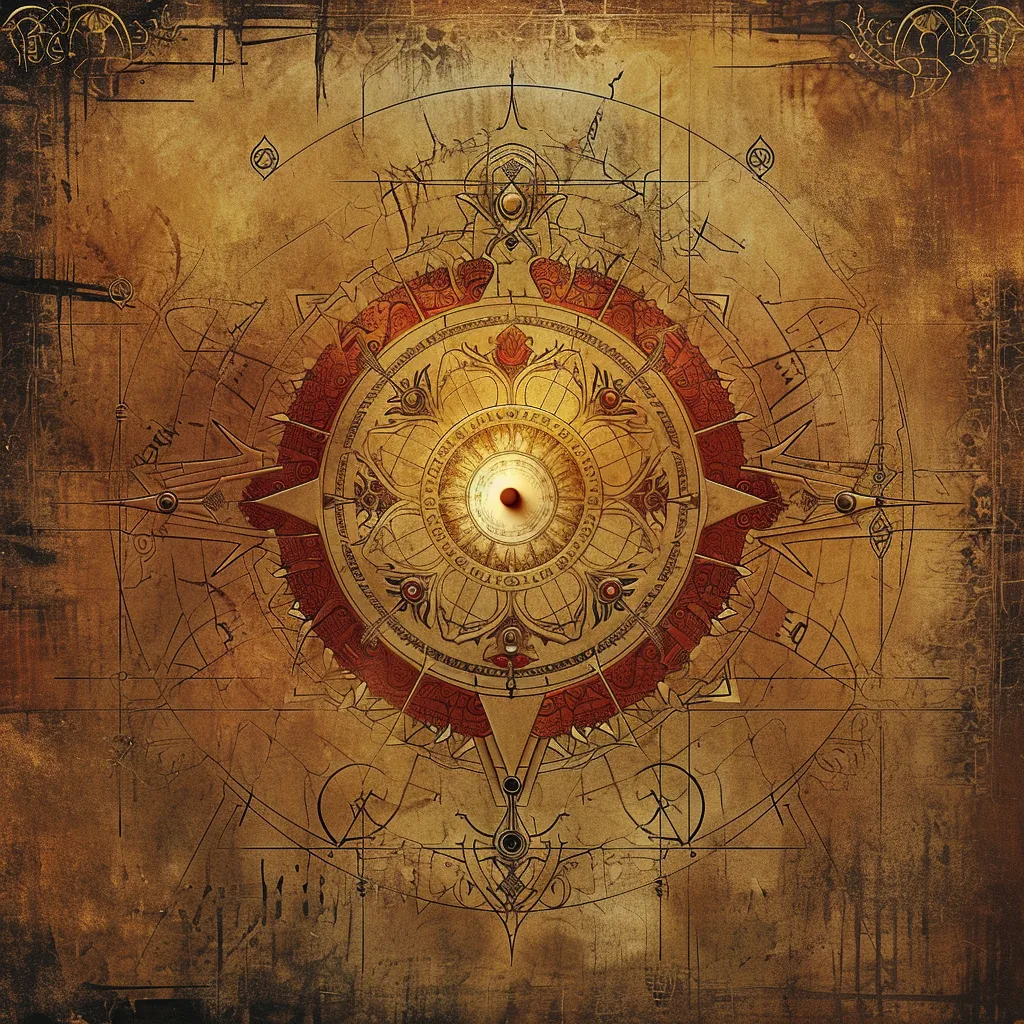Vodou developed in Haiti as an Afro-Caribbean religion synthesizing African, Native American, and European influences. Central to Vodou are the intricate symbolic drawings known as vèvè, used to invoke spirits during ceremonies.
These cosmograms encode a rich cosmology and draw on the mathematical principles of sacred geometry. As iconic cultural symbols, vèvè represent a confluence of art, spirituality, and identity in Haiti.
This article unveils the mystical significance and artistic complexity behind vèvè designs, from their origins to their enduring cultural impact.
- African roots
- Ritual usage
- Symbolic meaning
- Artistic heritage
- Cosmic science
The Origins and Evolution of Vèvè Symbols
Tracing back the origins of vèvè offers insight into how these captivating cosmograms came to be. Let’s turn back the clock and explore the interwoven cultural strands that spawned this unique artform!
African influences are central to the story. Similar to sand paintings used in rituals across Africa, vèvè designs recall the ritual ground drawings once used to harness spiritual forces. Enslaved Africans brought this tradition to the Americas and infused it with new layers of meaning.

But they didn’t develop vèvè in isolation! The syncretic nature of Vodou meant Native American and European esoteric ideas also left their mark. Occult symbols used by Freemasons and Kabbalists made their way into the repertoire. And borrowing from Indigenous tribes, vivid materials like cornmeal and flour replaced plain old dirt.
Over generations, these diverse strands interwove to spawn a unique Haitian incarnation of ritual drawings. The French colonists referred to them as “vevers,” derived from an old French word meaning ‘wand’ or ‘rod’. Haitians creolized this into the name we know today: vèvè.
Regional variations blossomed across the countryside:
- Angular lines in the north
- Flowing shapes in the south
- Intricate mosaics in the west
But a shared symbolic language united them all. Let’s decode the cosmic meanings encoded in these captivating sigils!
Decoding the Cosmic Language of Vèvè
Now let’s dive into demystifying the symbolism behind these mesmerizing cosmograms!
Invoking spirits during ceremonies is a sacred act that Vodou initiates and performs by drawing vèvè. Using materials like cornmeal, coffee, or flour, they trace intricate patterns on the ground. As they do so, the initiate chants prayers and songs to call the spirit into our world.
Each vèvè depicts a specific deity or spirit, so the choice of design is intentional and meaningful. Here are some of the most common motifs and their significance:
- Papa Legba’s vèvè shows his sacred staff and the crossroads he guards
- Damballah’s twin serpents represent his twining, life-giving power
- The swords of warrior spirits like Ogou Feray reflect their protective strength
- Zaka’s hoe, machete and bag evoke his ties to agriculture and the land
- Broken hearts pierce the vèvè of the fierce maternal spirit Erzulie Dantor

And that’s just scratching the surface! Vèvè ranges from straightforward emblems like these to mind-bogglingly complex mosaics. Every line and shape overflows with meaning.
To fully unlock vèvè symbolism, we must understand the cosmology, numerology, and sacred sciences underpinning their designs. More on that later! But first, let’s admire some of these stunning works of art.
The Artistic Legacy and Cultural Impact of Vèvè
Beyond their role in ceremonies, vèvè have left an indelible artistic imprint on Haitian culture. Their symbolic power continues to inspire creativity and tradition.
Firstly, vèvè motifs feature prominently in Haitian art. Paintings of vèvè adorn the walls of shops and restaurants across the country. The bold abstract styles of the Saint-Soleil school amplify their hypnotic geometry.
Textiles also weave vèvè designs into their patterns. The flowing shapes grace Haitian flags and banners during Vodou celebrations. And they bring good fortune when embroidered onto garments.

Of course, vèvè adds a spiritual flair to all kinds of jewelry and crafts as well. Their cosmic energy gets embedded into each necklace, bracelet, and figurine depicting these symbols.
Beyond Haiti’s shores, vèvè have also influenced Afro-Caribbean faiths like Santería. And lately, they’re inspiring trends in global fashion, decor, and branding.
Despite opposition from missionaries, the vèvè tradition persists as a celebration of the Vodou faith. These sacred sigils are iconic emblems of Haitian heritage and identity.
So next time you’re in Haiti, keep an eye out for vèvè symbolism! You’ll likely spot their unique shapes everywhere, from art galleries to hotel gift shops. For the full experience, attend a ceremony to witness Vèvè artwork and magic!
The Sacred Science of Vèvè
Under the captivating artistry of Vèvè lies a complex metaphysical framework based on sacred geometry, numerology, and cosmology.
Drawing a vèvè involves precise measurements and proportions connected to mystical concepts. The angles, shapes, and grid patterns echo cosmic blueprints found in systems like Ifá divination across Africa.
Specific numbers hold power. Selecting the right quantity of lines and curves channels vibrational energies.

In many ways, vèvè resembles mandalas, yantras, and other esoteric diagrams meant to focus intention and manifest change. The orientation and flow help direct spiritual forces.
By tapping into the matrix of mathematical and mystical knowledge encoded in vèvè, Vodou initiates bring devotees into closer alignment with the spirits.
These cosmic designs are technology—portals engineered to bridge the gulf between the mundane and the mystical realms!
Vèvè in the Vodou Temple and Home
Beyond ritual use, vèvè surround devotees in sacred spaces.
- Temples contain a central djevo pole adorned with a vèvè mosaic
- Elaborate vèvè adorn shrine rooms, doors, and wall murals. –Household shrines display vèvè honoring the resident family’s favored spirits –Body painting and garments allow wearing vèvè during ceremonies
- Vèvè symbolism appears on banners, drums, candles and offerings
Stepping into these environments, one is immersed in the energizing power of vèvè designs.
Their presence charges the space, opening portals for spirits to manifest. Vèvè shifts the atmosphere from mundane to magical through its intricate artistry and cosmic resonance.

Vèvè is a rich symbolic language for communicating with the spirits in Vodou. Their cosmic designs encode the traditions, beliefs, and cosmology of this fascinating Afro-Caribbean faith.
Beyond their ritual function, vèvè also form an important facet of Haitian art and culture. Their hypnotic shapes and meanings continue to inspire creativity, both within Haiti and across the globe.
To fully appreciate vèvè requires direct experience. Witnessing vèvè artistry firsthand by attending a ceremony offers an unparalleled portal into the magical heart of Vodou.
FAQ:
What are vèvè symbols?
Vèvè are intricate symbolic drawings used to invoke spirits in Haitian Vodou rituals and ceremonies. They serve as representations of the deities within Vodou cosmology.
What is the history and origin of vèvè designs?
Vèvè originated among enslaved Africans in colonial Haiti as a syncretic art form combining African, Native American, and European occult influences. Their name comes from an old French word for ‘wand’ or ‘rod’.
How are vèvè drawings used in Vodou rituals and ceremonies?
Vodou initiates trace vèvè on the ground using cornmeal, flour, or other materials while chanting prayers specific to the spirit depicted in the design. This summons the spirit’s presence during rituals.
What kind of materials are used to make vèvè?
Traditional materials used to draw vèvè include cornmeal, coffee, flour, beans, rice, eggshell powder, red brick powder, and charcoal. The choice depends on the ceremony and spirit being invoked.
What do common vèvè designs and motifs represent?
Common vèvè motifs include crosses and staffs for Papa Legba, intertwined serpents for Damballah, swords or machetes for Ogou, and hearts for Erzulie. Each symbol within a vèvè’s design holds a specific meaning.
How did vèvè develop as an artistic tradition in Haiti?
Over generations, vèvè evolved from simple ritual drawings into a sophisticated art form. Haitian artists like those of the Saint-Soleil school incorporated vèvè into their paintings. Vèvè designs also became prominent in crafts, textiles, jewelry, and decor.
What is the cultural significance of vèvè cosmograms?
As visual representations of Vodou spirits and cosmology, vèvè designs have deep cultural importance in Haiti. They are iconic symbols of Haitian heritage and identity, persisting despite opposition to Vodou.
Where can you see vèvè symbolism in Haiti today?
Vèvè symbolism appears widely in Haitian artwork, crafts, clothing, textiles, and decor. Their designs can even be spotted in hotel gift shops and galleries. Attending a Vodou ceremony offers a direct encounter.
Can outsiders attend authentic Vodou ceremonies to see vèvè?
With proper guidance and permission, respectful outsiders may be able to attend certain Vodou rituals and witness Vèvè drawings firsthand. However, many ceremonies are private.
How has Christian missionary activity affected Vèvè traditions?
Historically, some Christian missionaries have opposed Vodou and the vèvè art associated with it. But vèvè remains an integral part of Haitian culture and identity despite external religious pressures.



